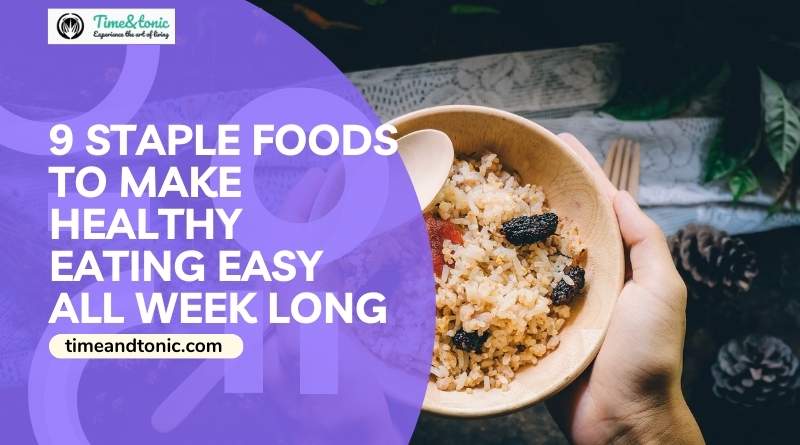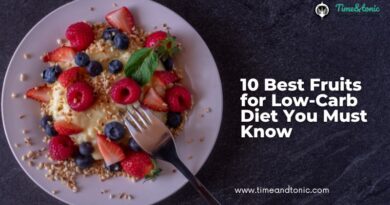9 Staple Foods to Make Healthy Eating Easy All Week Long
In our fast-paced lives, the idea of maintaining a healthy diet can often seem like a daunting task. The constant hustle and bustle, coupled with the ever-present allure of fast food and sugary treats, can make it challenging to stick to a nutritious eating plan. However, there’s a secret to making healthy eating almost effortless: stocking your pantry and fridge with the right staple foods.
These foundational ingredients form the backbone of nutritious and satisfying meals, helping you stay on track throughout the week. In this article, we’ll delve deeper into the nine staple foods that can transform your eating habits and make healthy living a breeze.
Staple Foods to Make Healthy Eating Easy All Week Long
1. Brown Rice: The Nutritional Powerhouse
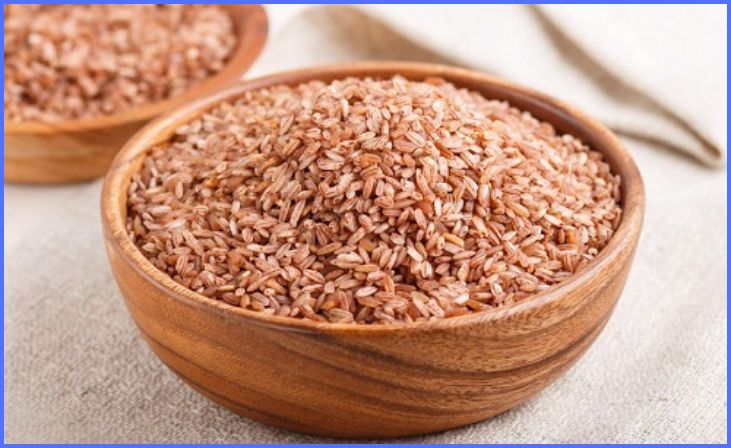
When it comes to staple foods, brown rice deserves a prime spot in your pantry. Unlike its refined counterpart, white rice, brown rice retains its outer bran layer, making it a whole grain rich in fiber, vitamins, and minerals. This makes it an excellent foundation for a wide range of dishes, including stir-fries and grain bowls. Its nutty flavor and hearty texture not only add depth to your meals but also keep you feeling full and satisfied for longer.
Beyond its satiating qualities, brown rice offers numerous health benefits. It’s a source of complex carbohydrates that provide a steady release of energy throughout the day. Additionally, it contains essential nutrients such as magnesium, manganese, and B-vitamins. Incorporating brown rice into your diet can help manage blood sugar levels and promote heart health, making it an indispensable addition to your healthy eating toolkit.
2. Quinoa: The Superfood Sensation
Quinoa, often hailed as a “superfood,” is a nutritional powerhouse that should be on every health-conscious individual’s radar. Packed with protein and fiber, quinoa is a versatile grain that can elevate your salads, side dishes, or even take center stage as a main course. Its protein content is particularly notable, as it contains all nine essential amino acids, making it a complete protein source.
Quinoa is also a rich source of antioxidants, vitamins, and minerals. It’s an excellent option for those seeking to increase their dietary fiber intake, as it supports digestive health and helps maintain a feeling of fullness. Whether you’re looking to create a hearty grain bowl, a protein-packed salad, or a flavorful side dish, quinoa is your go-to ingredient for nutritious and satisfying meals.
Also Read: 15 Power-Packed Healthy Snacks To Melt Belly Fat
3. Oats: The Breakfast Champion
Oats have long been a breakfast classic, and for good reason. These humble grains are brimming with fiber, which not only aids in digestion but also helps keep hunger at bay. Starting your day with a hearty bowl of oatmeal is a delicious and nutritious way to fuel your body and mind. Alternatively, oats can be incorporated into smoothies to add creaminess and a nutrient boost.
Beyond their breakfast appeal, oats offer a host of health benefits. They are known for their ability to lower cholesterol levels, thanks to a type of soluble fiber called beta-glucan. Oats are also a good source of vitamins, minerals, and antioxidants. With the versatility to be used in both sweet and savory dishes, oats are a must-have staple for maintaining a healthy diet.
4. Leafy Greens: Nature’s Nutrient Powerhouses
Leafy greens like spinach, kale, and lettuce are a treasure trove of essential vitamins and minerals. They are perfect for salads, green smoothies, or as a base for nutritious wraps and sandwiches. These vibrant greens are loaded with nutrients such as vitamin K, vitamin A, calcium, and iron, making them an integral part of any balanced diet.
One of the standout features of leafy greens is their low calorie content and high fiber content, which makes them an excellent choice for weight management. Additionally, their antioxidant properties can help combat oxidative stress and inflammation, promoting overall health and well-being. Including leafy greens in your daily meals ensures a steady influx of essential nutrients, contributing to your vitality and longevity.
5. Lean Protein: Building Blocks of a Healthy Body
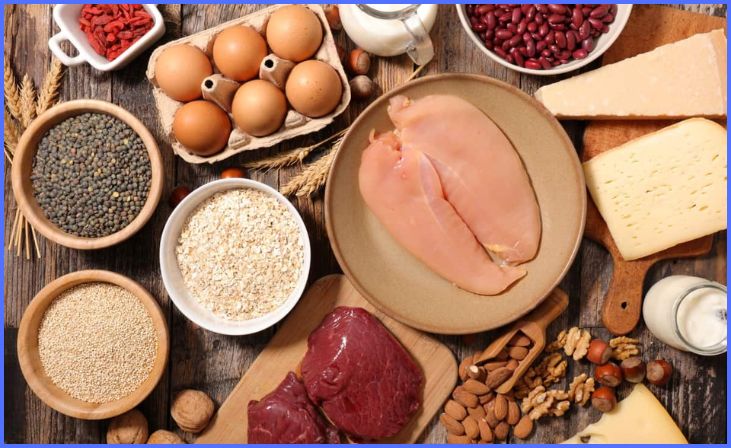
Protein is the cornerstone of a balanced diet, and incorporating lean protein sources into your meals can enhance their nutritional value and satiety. Options like chicken breast, turkey, tofu, and beans are versatile and can be used in countless recipes, from hearty soups to flavorful stir-fries.
Lean proteins offer numerous benefits beyond muscle maintenance and repair. They provide a feeling of fullness and satisfaction, reducing the likelihood of overeating. Additionally, they support weight management and can aid in fat loss by boosting metabolism and preserving lean muscle mass. Including lean protein in your diet helps you stay strong, energized, and on track with your healthy eating goals.
6. Fresh Vegetables: A Colorful Palette of Nutrition
Fresh vegetables are the foundation of a healthy diet, offering a plethora of essential vitamins, minerals, and antioxidants. Whether you’re stir-frying, sautéing, roasting, or simply enjoying them as crunchy snacks, a variety of colorful veggies can elevate your meals and boost your health.
The rainbow of colors in vegetables signifies a diverse range of nutrients. For instance, the vibrant orange hue of carrots indicates a high content of beta-carotene, a precursor to vitamin A, which supports vision and immune function. The deep green of broccoli signifies a wealth of vitamins K and C, as well as folate and fiber. By incorporating a diverse array of vegetables into your diet, you ensure that you’re getting a broad spectrum of nutrients to support your overall well-being.
Also Read: 7 Incredible Ways To Spend A Day for Mental Health
7. Healthy Fats: Enhancing Flavor and Health
Healthy fats, such as those found in avocados, nuts, and olive oil, are essential for overall health and can elevate the flavor of your meals. Avocado’s creamy texture, nuts’ satisfying crunch, and olive oil’s rich taste make them ideal choices for enhancing salads, spreads, and even desserts.
These heart-healthy fats offer a range of benefits. They provide a steady source of energy, support brain health, and help absorb fat-soluble vitamins. Additionally, they have anti-inflammatory properties that can reduce the risk of chronic diseases. By incorporating healthy fats into your diet in moderation, you can savor delicious flavors while reaping the rewards of improved health.
8. Greek Yogurt: A Protein-Packed Delight
Greek yogurt is a versatile and protein-rich dairy product that deserves a permanent spot in your fridge. It’s not only a nutritious snack but can also serve as a satisfying breakfast when topped with fresh fruits, nuts, or honey.
The high protein content in Greek yogurt makes it an excellent choice for those seeking to increase their protein intake. Protein is essential for muscle growth, tissue repair, and overall body function. Additionally, Greek yogurt is a source of probiotics, which promote gut health and aid in digestion. Including Greek yogurt in your diet not only supports your physical well-being but also satisfies your taste buds.
9. Frozen Fruits: Convenience Meets Nutrition
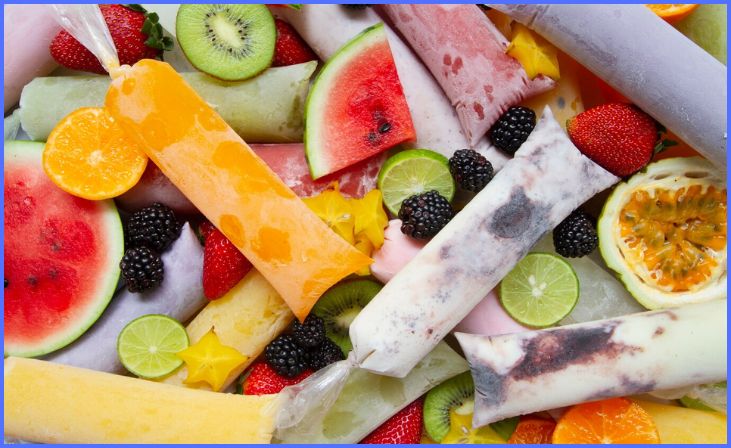
In our fast-paced lives, convenience is key to maintaining a healthy diet. Frozen fruits are a convenient way to add nutrition and flavor to your meals without the worry of spoilage. By keeping a variety of frozen berries and fruits in your freezer, you can effortlessly whip up quick and healthy smoothies or use them as a base for easy desserts.
Also Read: 8 Healthy Dinner Ideas for Two Perfect for Date Night
Frozen fruits are just as nutritious as their fresh counterparts, as they are typically frozen at their peak ripeness, preserving their vitamins and minerals. They are a versatile ingredient, perfect for blending into smoothies, mixing into yogurt, or baking into healthy treats. With frozen fruits at your disposal, you can satisfy your sweet cravings with a guilt-free twist.
In conclusion, maintaining a healthy diet doesn’t have to be an arduous task, even with busy schedules and temptations lurking around every corner. By stocking your kitchen with these nine essential staple foods – brown rice, quinoa, oats, leafy greens, lean protein, fresh vegetables, healthy fats, Greek yogurt, and frozen fruits – you can set yourself up for success.
These foundational ingredients provide the building blocks for nutritious and satisfying meals, making healthy eating not only achievable but also enjoyable. So, take the first step in your journey to a healthier you by filling your pantry and fridge with these essential staples. Your body and taste buds will thank you for it!
FAQs
Yes, you can substitute brown rice for white rice in most recipes. Brown rice is a healthier whole grain option that adds a nutty flavor and more nutrients to your dishes.
To keep frozen fruits fresh, store them in an airtight container or resealable freezer bag in the freezer. Ensure they’re properly sealed to prevent freezer burn, and they can last for several months.

